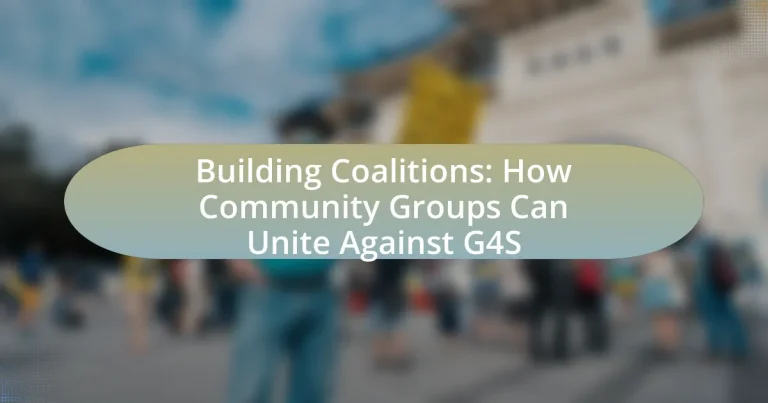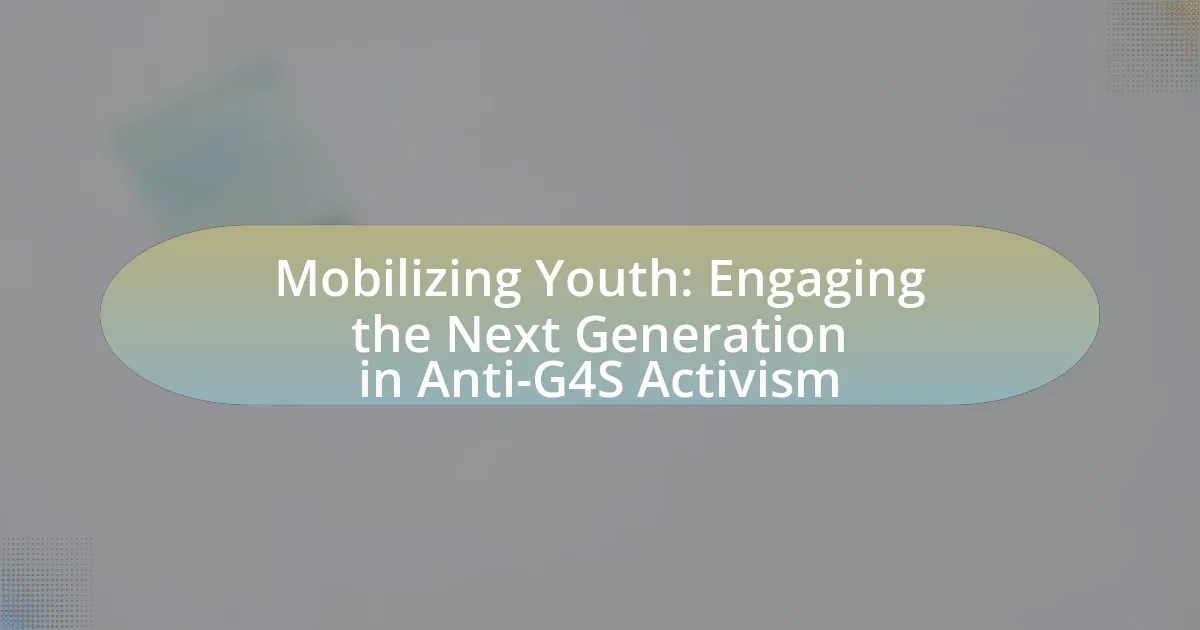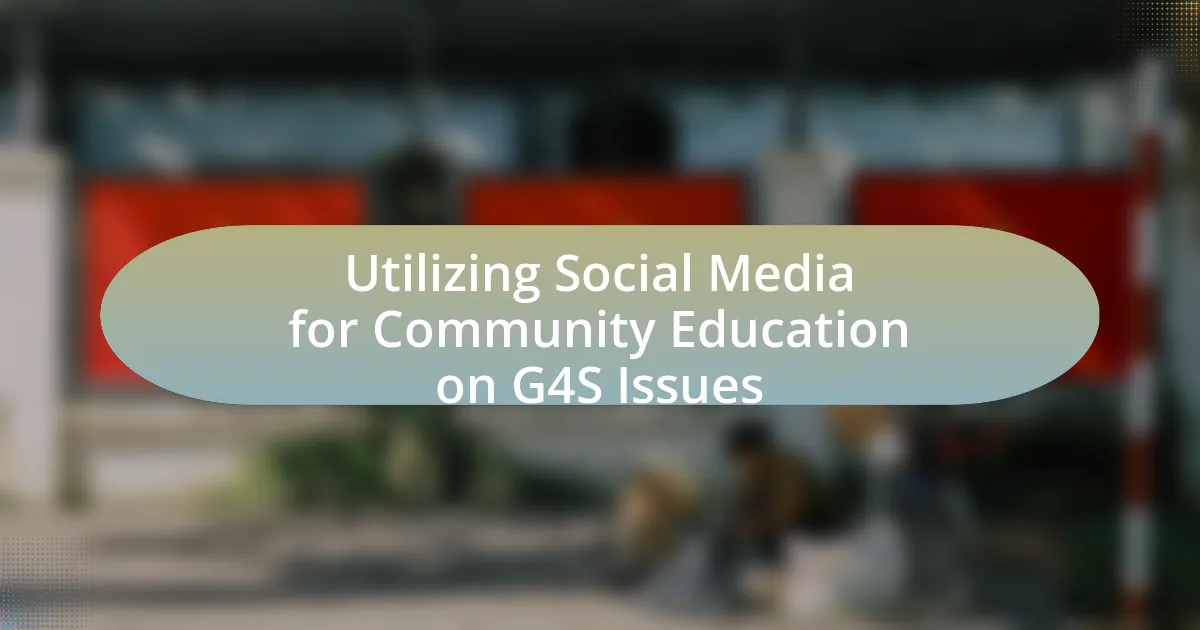The article focuses on the challenges posed by G4S in communities, particularly regarding security practices, labor relations, and community trust. It highlights how G4S’s operations can lead to tensions between local residents and law enforcement, as well as issues related to human rights abuses and inadequate working conditions for employees. The article emphasizes the importance of community groups uniting to address these challenges through coalition-building, which can enhance advocacy effectiveness and amplify their collective voice. Strategies for forming and sustaining coalitions, as well as methods for raising awareness and engaging in policy advocacy against G4S, are also discussed, providing a comprehensive framework for community action.
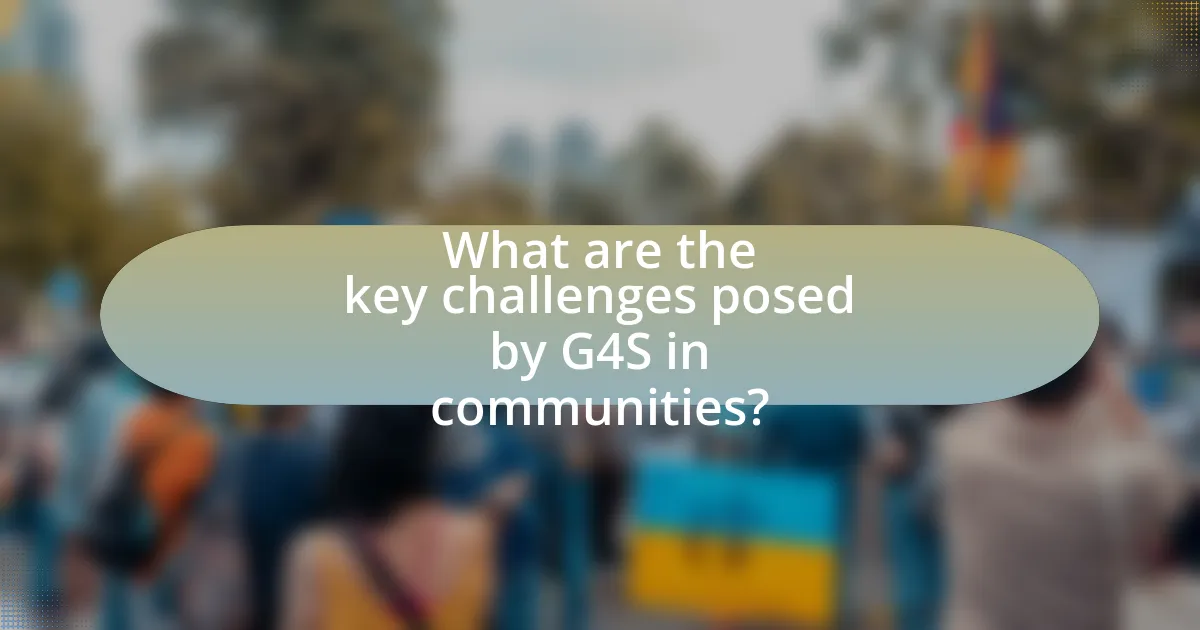
What are the key challenges posed by G4S in communities?
G4S poses several key challenges in communities, primarily related to security practices, labor relations, and community trust. The company’s security operations can lead to increased tensions between local residents and law enforcement, as aggressive policing tactics may disproportionately affect marginalized groups. Additionally, G4S has faced criticism for labor practices, including low wages and inadequate working conditions for its employees, which can contribute to community dissatisfaction. Furthermore, incidents involving G4S personnel, such as allegations of misconduct or excessive force, can erode public trust and create divisions within communities. These challenges highlight the need for community groups to unite and address the impacts of G4S’s operations collaboratively.
How does G4S impact local communities?
G4S impacts local communities primarily through its security services, which can enhance safety but also lead to concerns about surveillance and policing. The presence of G4S can create a perception of increased security, potentially reducing crime rates in certain areas. However, this can also result in community tensions, particularly in neighborhoods where residents feel over-policed or targeted. For instance, studies have shown that private security firms like G4S can contribute to a culture of surveillance that disproportionately affects marginalized groups, leading to calls for community coalitions to address these issues.
What specific issues arise from G4S’s operations?
G4S’s operations face specific issues including allegations of human rights abuses, inadequate training of personnel, and concerns over the privatization of public services. Human rights organizations have reported instances of excessive force and mistreatment of detainees in facilities managed by G4S, highlighting a pattern of misconduct. Additionally, the company’s security personnel often receive insufficient training, leading to operational failures and safety risks. The privatization of public services, particularly in the criminal justice sector, raises ethical concerns about accountability and transparency, as G4S’s profit motives may conflict with the public interest. These issues collectively undermine trust in G4S and prompt community groups to mobilize against its operations.
How do these issues affect community safety and trust?
Issues related to community safety and trust are significantly impacted by the actions and policies of organizations like G4S. When community members perceive that security measures are overly aggressive or discriminatory, it leads to a breakdown in trust between the community and law enforcement or security providers. For instance, studies have shown that communities with high levels of perceived police misconduct experience increased fear and decreased cooperation with law enforcement, which ultimately undermines public safety. Furthermore, when community groups unite against perceived injustices, such as those associated with G4S, it can foster a sense of solidarity and collective efficacy, enhancing community resilience and safety.
Why is it important for community groups to unite against G4S?
It is important for community groups to unite against G4S to amplify their collective voice and influence in advocating for social justice and accountability. By coming together, these groups can share resources, strategies, and information, which enhances their ability to challenge G4S’s practices, such as its involvement in controversial detention and security operations. Historical examples, such as the successful campaigns against private prison companies, demonstrate that unified efforts can lead to significant policy changes and increased public awareness. This collaboration not only strengthens their position but also fosters solidarity among diverse communities affected by G4S’s actions.
What are the potential benefits of coalition-building?
Coalition-building offers several potential benefits, including increased collective power, resource sharing, and enhanced advocacy effectiveness. By uniting diverse groups, coalitions amplify their voices, making it easier to influence policy and public opinion. For instance, research shows that coalitions can lead to more significant social change, as seen in movements like the Civil Rights Movement, where various organizations collaborated to achieve common goals. Additionally, coalitions facilitate the pooling of resources, allowing member organizations to leverage each other’s strengths, expertise, and networks, ultimately leading to more impactful initiatives.
How can unity amplify the voices of community groups?
Unity can amplify the voices of community groups by fostering collaboration and creating a stronger collective presence. When community groups unite, they can pool resources, share information, and coordinate efforts, which enhances their visibility and influence. For instance, a study by the National Council of Nonprofits highlights that coalitions can increase advocacy effectiveness by 50% through combined efforts. This collective action not only raises awareness of shared issues but also attracts greater media attention and public support, ultimately leading to more significant impact in addressing concerns related to organizations like G4S.
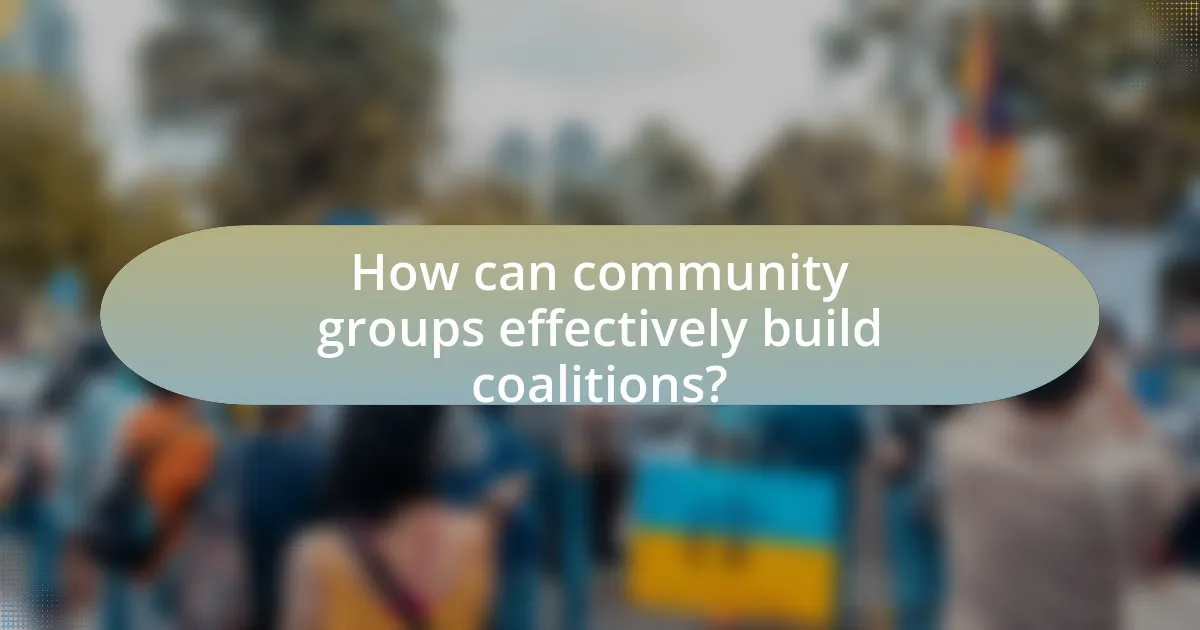
How can community groups effectively build coalitions?
Community groups can effectively build coalitions by establishing clear goals, fostering open communication, and engaging diverse stakeholders. Clear goals provide a shared vision that aligns the interests of various groups, making collaboration more focused and productive. Open communication ensures that all members feel valued and heard, which strengthens relationships and trust among coalition partners. Engaging diverse stakeholders, including marginalized communities, enhances the coalition’s reach and effectiveness, as it brings in different perspectives and resources. Research shows that coalitions with diverse membership are more successful in achieving their objectives, as they can mobilize broader community support and resources.
What strategies can be employed to form coalitions?
To form coalitions, community groups can employ strategies such as identifying common goals, establishing clear communication channels, and leveraging existing networks. Identifying common goals ensures that all parties have a shared vision, which is crucial for unity and collaboration. Establishing clear communication channels facilitates transparency and trust among coalition members, allowing for effective coordination and decision-making. Leveraging existing networks can enhance resource sharing and broaden the coalition’s reach, as seen in successful movements where groups have collaborated to amplify their voices and impact. For example, the Fight for $15 movement effectively united various labor organizations and community groups by focusing on the shared objective of raising the minimum wage, demonstrating the power of strategic coalition-building.
How do shared goals enhance coalition effectiveness?
Shared goals enhance coalition effectiveness by aligning the interests and efforts of diverse groups towards a common objective. When coalition members have a unified purpose, it fosters collaboration, increases motivation, and facilitates resource sharing, which are critical for achieving collective outcomes. Research indicates that coalitions with clearly defined shared goals are more likely to succeed in their initiatives, as evidenced by a study published in the Journal of Community Psychology, which found that coalitions with aligned objectives reported higher levels of engagement and effectiveness in their campaigns.
What role does communication play in coalition-building?
Communication is essential in coalition-building as it facilitates understanding, alignment of goals, and collaboration among diverse groups. Effective communication ensures that all stakeholders are informed about the coalition’s objectives, strategies, and progress, which fosters trust and commitment. Research indicates that coalitions with strong communication practices are more likely to achieve their goals, as they can effectively mobilize resources and engage members. For instance, a study by the National Network of Sector Partners found that clear communication channels significantly enhance coalition effectiveness by promoting shared decision-making and collective action.
What are the common pitfalls in coalition-building?
Common pitfalls in coalition-building include lack of clear goals, insufficient communication, and failure to establish trust among members. Without clear goals, coalitions may struggle to align their efforts, leading to confusion and inefficiency. Insufficient communication can result in misunderstandings and disengagement, as members may feel uninformed or undervalued. Additionally, failure to establish trust can hinder collaboration, as members may be reluctant to share resources or information. Research indicates that successful coalitions prioritize these elements to enhance effectiveness and sustainability.
How can community groups avoid fragmentation?
Community groups can avoid fragmentation by fostering collaboration through regular communication and shared goals. Establishing clear objectives that align with the interests of all members encourages unity and reduces the likelihood of divergent paths. Research indicates that coalitions with defined missions and consistent engagement strategies are more effective in maintaining cohesion, as seen in the work of the Community Tool Box, which emphasizes the importance of collective action in community organizing. By prioritizing inclusivity and actively involving all stakeholders in decision-making processes, community groups can strengthen their bonds and work more effectively towards common objectives.
What strategies help maintain coalition momentum?
Effective strategies to maintain coalition momentum include regular communication, shared goals, and active engagement of all members. Regular communication ensures that all coalition members are informed and aligned, fostering a sense of unity and purpose. Establishing shared goals helps to focus efforts and resources, creating a collective vision that motivates participants. Active engagement, through meetings, events, and collaborative projects, encourages participation and strengthens relationships among members. Research indicates that coalitions with strong communication and clear objectives are more likely to sustain their efforts over time, as evidenced by successful community initiatives that have led to significant social change.
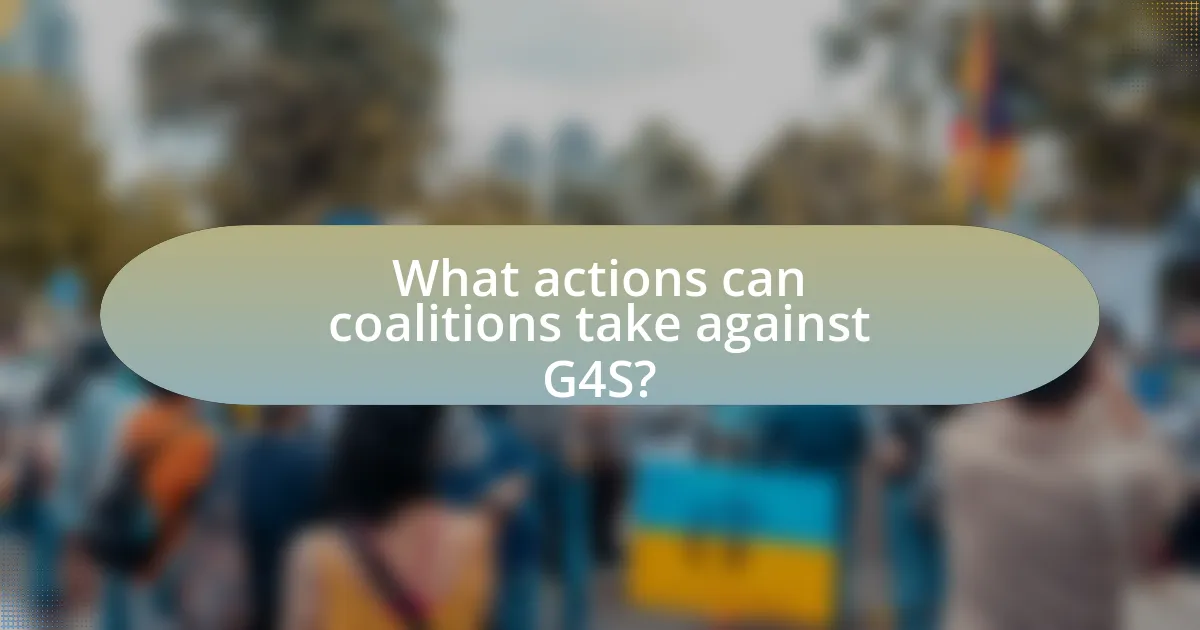
What actions can coalitions take against G4S?
Coalitions can take various actions against G4S, including organizing protests, advocating for policy changes, and raising public awareness about the company’s practices. Protests can draw attention to specific issues, such as human rights violations or unethical business practices, thereby mobilizing community support. Advocacy for policy changes can involve lobbying local governments to reconsider contracts with G4S or to implement stricter regulations on security firms. Additionally, coalitions can utilize social media campaigns to inform the public and generate widespread discourse on G4S’s impact, leveraging statistics and reports that highlight the company’s controversial actions, such as its involvement in immigration detention centers or security operations in conflict zones.
How can coalitions raise awareness about G4S’s impact?
Coalitions can raise awareness about G4S’s impact by organizing community outreach programs that educate the public on the company’s practices and their consequences. These programs can include workshops, informational campaigns, and public demonstrations that highlight specific issues such as human rights violations or environmental concerns associated with G4S operations. For instance, research by Amnesty International has documented instances of G4S’s involvement in controversial detention practices, which can serve as a focal point for coalition messaging. By leveraging social media platforms and local media coverage, coalitions can amplify their message and reach a broader audience, thereby increasing public scrutiny of G4S’s activities.
What methods are effective for community outreach?
Effective methods for community outreach include organizing community events, utilizing social media platforms, and forming partnerships with local organizations. Community events, such as workshops or town hall meetings, foster direct engagement and allow for face-to-face interaction, which builds trust and rapport among community members. Social media platforms enable broader reach and facilitate real-time communication, making it easier to disseminate information and gather feedback. Partnerships with local organizations leverage existing networks and resources, enhancing outreach efforts and increasing community involvement. These methods have been shown to improve participation rates and strengthen community ties, as evidenced by various case studies highlighting successful outreach initiatives.
How can social media be leveraged for advocacy?
Social media can be leveraged for advocacy by facilitating communication, mobilizing supporters, and amplifying messages. Platforms like Twitter and Facebook allow organizations to share information quickly, engage with followers, and create campaigns that raise awareness about issues. For instance, the #BlackLivesMatter movement effectively utilized social media to organize protests and spread its message globally, demonstrating the power of online platforms in driving social change. Additionally, studies show that social media campaigns can increase public engagement and influence policy decisions, as seen in various advocacy efforts that gained traction through viral content and community support.
What legal avenues are available for coalitions?
Coalitions have several legal avenues available to them, including forming nonprofit organizations, engaging in lobbying activities, and utilizing litigation to address grievances. Nonprofit organizations can provide coalitions with a formal structure, allowing them to apply for grants and engage in fundraising. Lobbying activities enable coalitions to influence legislation and public policy by advocating for specific issues. Additionally, coalitions can pursue litigation to challenge unlawful practices or policies, as seen in cases where community groups have successfully sued corporations for violations of civil rights or environmental laws. These legal avenues empower coalitions to effectively advocate for their interests and achieve their objectives.
How can coalitions engage in policy advocacy?
Coalitions can engage in policy advocacy by uniting diverse stakeholders to amplify their collective voice and influence decision-makers. By collaborating, coalitions can share resources, expertise, and strategies, which enhances their ability to effectively lobby for specific policy changes. For instance, coalitions can organize campaigns, conduct research to support their positions, and mobilize community members to participate in advocacy efforts, thereby increasing public awareness and pressure on policymakers. This approach has been validated by successful initiatives where coalitions have led to significant legislative changes, demonstrating the power of collective action in shaping public policy.
What are the implications of legal action against G4S?
Legal action against G4S can lead to significant financial and reputational consequences for the company. Such legal proceedings may result in substantial monetary penalties, which could impact G4S’s profitability and operational budget. Additionally, negative media coverage surrounding the legal issues can damage the company’s public image, leading to a loss of trust among clients and stakeholders. This erosion of reputation may also hinder G4S’s ability to secure future contracts, particularly in sensitive sectors like security and prison management, where public perception is crucial. Furthermore, ongoing legal challenges can divert resources and attention away from core business operations, potentially affecting overall performance and employee morale.
What are best practices for sustaining coalition efforts?
Best practices for sustaining coalition efforts include establishing clear goals, maintaining open communication, and fostering trust among members. Clear goals provide a shared vision that aligns the coalition’s activities, while open communication ensures that all members are informed and engaged in decision-making processes. Trust among coalition members is crucial for collaboration and can be built through transparency and accountability. Research indicates that coalitions with strong communication and trust are more effective in achieving their objectives, as evidenced by successful community initiatives that have led to significant policy changes.
How can coalitions ensure long-term engagement from members?
Coalitions can ensure long-term engagement from members by fostering a strong sense of community and shared purpose. This can be achieved through regular communication, inclusive decision-making processes, and opportunities for members to contribute their skills and resources. Research indicates that organizations with high member involvement in decision-making report greater satisfaction and retention rates, as seen in studies conducted by the National Council of Nonprofits, which highlight that engaged members are more likely to remain active and committed. Additionally, providing ongoing training and development opportunities can enhance members’ skills and investment in the coalition’s goals, further solidifying their long-term engagement.
What metrics can be used to measure coalition success?
Metrics that can be used to measure coalition success include member engagement, policy impact, resource mobilization, and public awareness. Member engagement can be assessed through participation rates in meetings and events, indicating the level of commitment among coalition members. Policy impact can be evaluated by tracking changes in legislation or policy outcomes that result from coalition efforts, demonstrating the coalition’s effectiveness in influencing decision-makers. Resource mobilization metrics, such as funding raised or in-kind contributions secured, reflect the coalition’s ability to garner support and sustain its initiatives. Lastly, public awareness can be measured through media coverage and community outreach efforts, showcasing the coalition’s visibility and influence in the public sphere. These metrics provide a comprehensive framework for assessing the effectiveness and impact of coalitions in achieving their goals.
